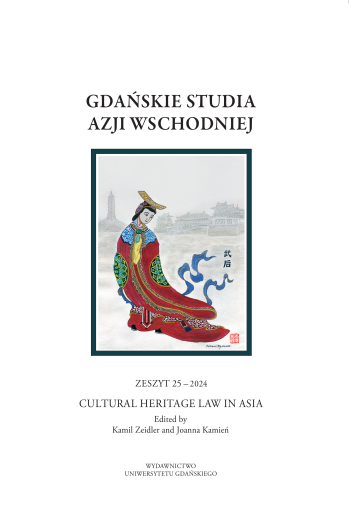Vietnam’s cultural heritage protection laws (1900–2023) and their pros & cons from the position of Vietnam’s new generation: Case studies
Vietnam’s cultural heritage protection laws (1900–2023) and their pros & cons from the position of Vietnam’s new generation: Case studies
Author(s): Nguyen Le Uyen PhuongSubject(s): Law, Constitution, Jurisprudence, Museology & Heritage Studies, Library and Information Science, Criminal Law, Civil Law, Public Law
Published by: Wydawnictwo Uniwersytetu Jagiellońskiego
Keywords: heritage protection law; Vietnam; Vietnam War; renovation period
Summary/Abstract: The article aims, first, to examine the evolution of cultural heritage protection in Vietnam from 1900 to 2023, focusing on the Vietnam War, renovation (1980–2000), and international integration (since 1987). Second, it analyses the Cultural Heritage Law 2001 and the Amending of Cultural Heritage Law 2009, the two main texts governing this field. Third, it presents case studies of the challenges and successes of cultural heritage protection as it is perceived by the Vietnamese new generation and by the Vietnam government as part of the market economy.The author observe that historical events strongly shaped the Vietnamese Cultural Heritage Law (CHL). Changing definitions of CHL over time reflect citizens’ ideology in conserving cultural heritage. Further, the Constitution of Vietnam (1946, 1959, 1980, and 1992) differs in its CHL orientation via three major stages. Every time legal basics and political situations change, CHL documents will serve various interests. Finally, the Vietnamese new generation’s cultural heritage education and distribution achievements are discussed.Author demonstrates that the Vietnam War was the most difficult time for CHL growth. Decree 65 and the 1946 Constitution’s generic definitions were responding to complex political conditions and were not intended to promote CHL. Vietnam became a socialist country under Soviet influence during reconstruction (1980–2000). The 1980 Constitution is strong enough to govern historic resource ownership and conservation, as is shown by new cultural heritage documents like Ordinance 14 (1984) and Decree 28 (1985). However, the ability to exploit heritage and obtain worldwide recognition was limited. Vietnamese CHL had access to international treaties and recommendations when Vietnam joined UNESCO in the international integration period (after 1987). In this period, the 1992 Constitution (internal role) and an international source (external role) inspired the 2001 CHL and 2009 Amendment to CHL. Both documents still play a principal main role in enabling Vietnam to enter the Heritage Economy.Young Vietnamese citizens’ achievements promote cultural values and involvement. However, Vietnamese teens have not paid attention to develop the legal aspects of CHL. Unanswered is the issue of whether Vietnam’s legal framework is robust enough to prevent abuses in heritage exploitation.
Journal: Gdańskie Studia Azji Wschodniej
- Issue Year: 2024
- Issue No: 25
- Page Range: 225 - 250
- Page Count: 26
- Language: English

